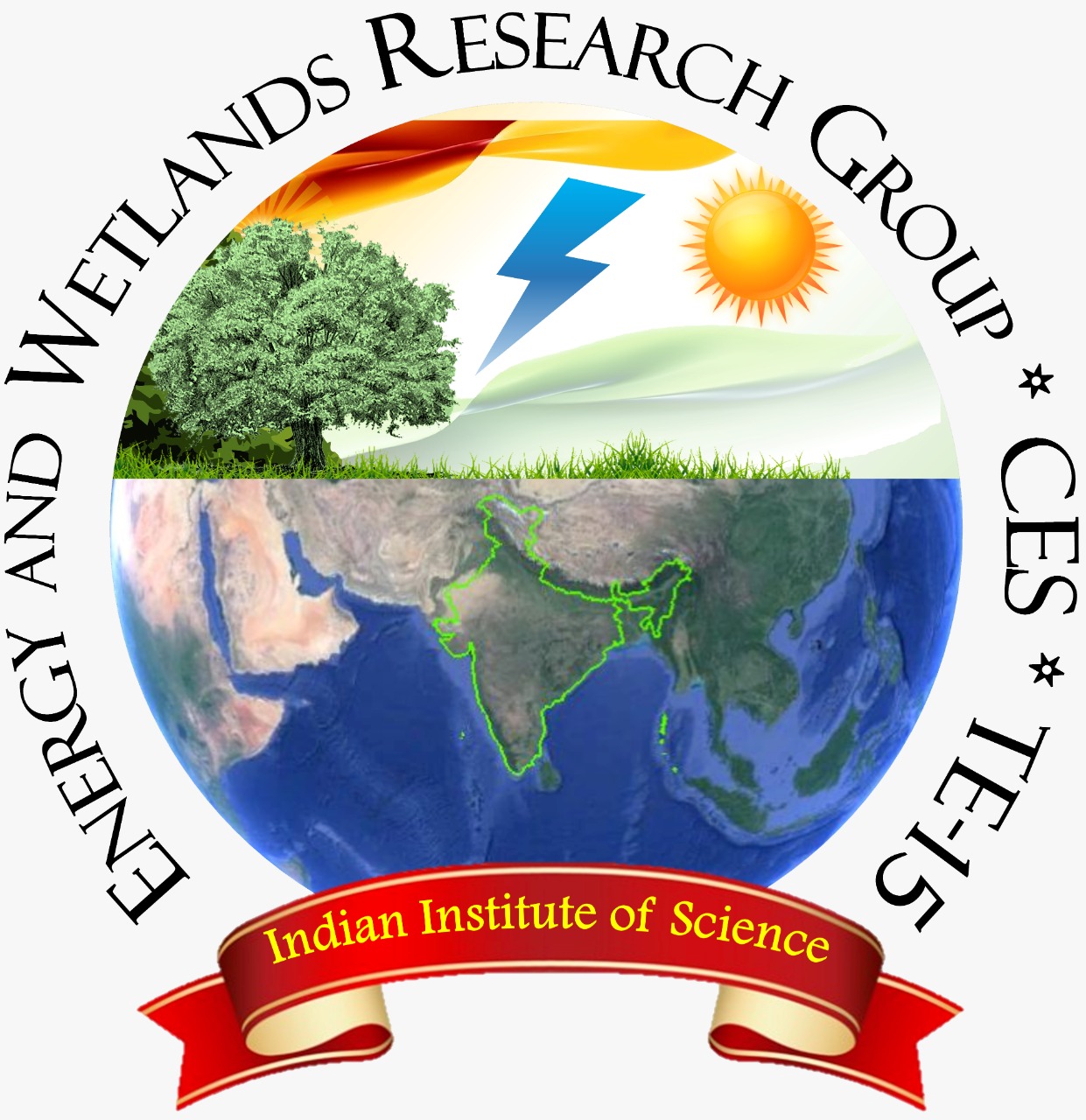|
Introduction
Wetlands are transitional zones between land and water resources and play a significant role in the ecological sustainability of the region, while constituting the most productive ecosystems. A wetland is referred to an area that is periodically or permanently inundated with the surface or groundwater, which supports the growth of diverse aquatic vegetation (Ramachandra et al., 2011; Mitsch and Gosselink, 2000). Wetlands play a prominent role in meeting the domestic and irrigation needs of the region apart from being habitats for a wide variety of flora and fauna. The quality and hydrologic regime of the wetlands is directly dependent on the integrity of its watershed (catchment or basin). Wetlands function as kidneys of the landscape and help as a sink to myriads of toxic compounds and pollutants. However, an excess inflow of nutrients and other contaminants beyond the treatment capability results in changes in the water quality, impairing the ecological functions and hampering the ecological integrity of aquatic ecosystems. The sustained inflow of untreated or partially treated sewage to water bodies leads to the enrichment of nutrients such as nitrogen (N) and phosphorus (P), which is evident from the algal blooms and profuse growth of macrophytes. This has led to eutrophication of the surface water. This has also contaminated nearby groundwater sources via leaching affecting human health. Unplanned rapid urbanization in recent years has led to the deterioration of wetlands. The sustained inflow of untreated or partially treated sewage to wetlands leads to the enrichment of nutrients such as nitrogen (N) and phosphorus (P), which is evident from the algal blooms and profuse growth of macrophytes. This has led to eutrophication of the surface water. This has also contaminated nearby groundwater sources via leaching, which affects human health. Nitrogen as nitrate-N pollution leads to physiological disorders including blue baby syndrome (methemoglobinemia) and the persistent assimilation of nitrate rich water leads to carcinogenic symptoms (as nitrosamines, which are carcinogens) (Ramachandra et al., 2014; Mahapatra et al., 2011; 2013). Heavy metals are elements with atomic number >20 that possess higher density (>5 g/cm³) and metallic properties and mainly include cadmium (Cd), chromium (Cr), copper (Cu), mercury (Hg), lead (Pb), cobalt (Co), iron (Fe), nickel (Ni), manganese (Mn), zinc (Zn) and arsenic (As). These heavy metals are mainly released from industrial processes, industrial discharges, mining operations, etc. Heavy metals are one of the most toxic chemicals that have been posing challenges to decision-makers. Heavy metals are elements with atomic number >20 that possess higher density (>5 g/cm³) and metallic properties and mainly include cadmium (Cd), chromium (Cr), copper (Cu), mercury (Hg), lead (Pb), cobalt (Co), iron (Fe), nickel (Ni), manganese (Mn), zinc (Zn) and arsenic (As). These heavy metals are mainly released from industrial processes; industrial discharges, mining operations, and acid mine drainage (Rungwa et al., 2013). These heavy metals move through various biogeochemical cycles and enter the food chain resulting in bioaccumulation and consequent bio-magnifications. The non-biodegradable nature and long biological half-life of heavy metals, when compared to other xenobiotics, are the reasons for various environmental problems. The primary sources of heavy metals into the environment are; fertilizers, pesticides, untreated or partially treated wastewater, leachates from mining sites, industrial wastes (e-wastes), wastes from smelting ores, and sewage sludge. LITERATURE REVIEWS Cultivation of vegetables and other food crops in heavy metal contaminated sites or irrigation with heavy metal contaminated water may result in uptake of such contaminants from soil, ultimately resulting in its accumulation in edible portions of vegetables (Sun et al., 2016). Vegetable like Pudina (Mentha spicata), Coriander, (Coriandrum sativum), Spinach (Spinacia oleracea), etc. grown in tropical India contained various heavy metals (e. g. Pb, Zn, Cd, Cr, Cu, and Ni) with concentrations exceeding their safe limits (Gupta et al., 2012). Concentrations of Pb, Zn, Cd, and Cr in all the sewage-fed vegetables were beyond the safe limits of FAO/WHO and Indian standards. The concentration of zinc was high in the vegetables than other metals ranging from 90.87 to 148.02 mg/Kg. Daily intake values of Pb, Cd, and Ni through consumption of sewage-fed vegetables exceeded the recommended oral dose of metal for adults and children. Paddy grown in arsenic-contaminated soil accumulated Dimethyl arsenic acid (DMA), a carcinogenic substance (Ye et al., 2011). Heavy metal analysis in vegetables grown near an e-waste recycling facility in China (Luo et al., 2011) showed that the soils of former incineration sites had high concentrations of Cd, Cu, Pb, and Zn with mean values of 17.1, 11,140, 4500, and 3690mg/kg, respectively. In the edible tissues of vegetables, the concentrations of Cd and Pb in most samples exceeded the maximum level permitted for food in China. Sequential leaching tests revealed that the Cu, Pb, and Zn were predominantly associated with the residual fraction, followed by the carbonate/specifically adsorbed phases except for Cd, which was mainly in the extractable form in paddy fields and vegetable soils. Uptake of heavy metals by some edible vegetables irrigated using wastewater revealed a mean concentration in the order of Fe (183.11±161.2)>Zn (5.38±3.50)>Ni (3.52±1.27)>Pb (2.49±1.81)>Cr (1.46±0.51)>Co (0.66±0.25)>Cd (0.36±0.15). The water samples used for irrigation were found to be unsuitable for irrigation due to high SAR values (Ackah et al., 2014). Transportation and marketing systems of vegetables play a significant role in elevating the contaminant levels of heavy metals pose a threat to the quality of the vegetables with health consequences of the consumers of locally produced foodstuffs (Sharma et al., (2009). Heavy metal analysis in vegetables grown in an industrial area in Dhaka, Bangladesh the contaminations in the order of metal contents Fe > Cu > Zn > Cr > Pb > Ni >Cd in contaminated irrigation water, and a similar pattern Fe > Zn > Ni > Cr > Pb > Cu > Cd was also observed in arable soils. Metal levels observed in different sources were compared with WHO, SEPA, and established permissible levels. The mean concentration of Cu, Fe, and Cd in irrigation water and Cd content in soil were much above the recommended level. Accumulation of the heavy metals in vegetables studied was lower than the recommended maximum tolerable levels proposed by the Joint FAO/WHO Expert Committee on Food Additives (1999), except Cd, which exhibited elevated content. Vegetables with protein, vitamins, iron, calcium, and other essential micro-nutrients constitute essential diet components. Contamination of vegetables grown with the city effluents has been posing a serious threat to humans evident from the enhanced episodes of various health disorders in the catchment. Heavy metals in vegetables are harmful to human beings due to their non-biodegradable nature, long biological half-lives, and their potential to accumulate in different body parts (Monu et al., 2008). Prolonged consumption of such heavy metal contaminated vegetables through foodstuffs may lead to chronic accumulation of heavy metals in human beings' kidney and liver, disrupting numerous biochemical processes, leading to cardiovascular, neural, kidney and bone diseases. Furthermore, heavy metal contamination can seriously deplete some essential nutrients in the body, causing a decrease in immunological defenses, intra-uterine growth retardation, impaired physico-social behavior, disabilities associated with malnutrition, and a high prevalence of upper gastrointestinal cancer. The nature of effect can be toxic (acute, chronic or sub-chronic), neurotoxic, carcinogenic, mutagenic or teratogenic (European Union, 2002). Considering the serious health threat, there is an urgent need to remove the heavy metals to minimize its interventions in humans’ food chain. Wetlands plants can uptake heavy metals and allow the water through them (before letting into crop or vegetable field) would help in the remediation, and this process is often termed as ‘Phytoremediation’. Phytoremediation takes advantage of the natural processes of plants and is a cost-effective treatment technique for the removal of both organic and inorganic contaminants (Meagher, 1996; Passatore et al., 2014; Campos et al., 2008; Ahalya and Ramachandra, 2006 ). These processes include water and chemical uptake, metabolism within the plant, exudate released into the soil that leads to contaminant loss, and the physical, biochemical impacts of the plant roots. More than 400 plant species have been identified to have the potential for soil and water remediation (Brook R. R., 1998). The heavy metal removal mechanisms in plants include (i) uptake, (ii) translocation, and (iii) storage. The absorption of metals (for e.g., Pb) by roots occurs via the apoplastic pathway or via Ca²+ permeable channels. The behaviour of metals in soil and uptake by plants is controlled by its speciation and soil pH, soil particle size, cation-exchange capacity, root surface area, root exudation, and degree of mycorrhizal transpiration (Hopkins and Huner, 2009; Dhir, 2010,2013). Before the metal can move from the soil solution into the plant, it must pass the surface of the root. This can either be the movement of metal ions passing through the porous cell wall of the root cells, by which metal ions move symplastically through the cells of the root (Ali et al., 2013, Hopkin sand Huner, 2009). Special plant membrane proteins bind with specific metals and become ready for uptake and transport. Root to shoot transport - elements are transported via the vascular system to the above-soil biomass (shoots). Different chelators are involved in the translocation of metal cations through the xylem, such as organic acid chelators - malate, citrate, histidine, or nicotianamine (Ali et al., 2013). Since the metal is complexed within a chelate, it can be translocated upwards in the xylem without being adsorbed by the high cation exchange capacity of the xylem. The transported metals are stored in the plant cell's vacuoles (Taiz and Zeiger, 2003). Heavy metals like arsenic (as arsenate) might be taken up by plants due to the similarities to the plant nutrient phosphate, while Selenium (Se) replaces the nutrient sulphur in compounds taken up by a plant (Brooks, 1998). AIM OF THE STUDY The Objective of the current study is to assess the heavy metal accumulation in vegetables.
|

